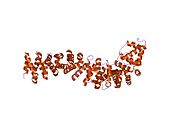CTNNBIP1
Beta-catenin-interacting protein 1 is a protein that is encoded in humans by the CTNNBIP1 gene.[5][6]
Function
[edit]The protein encoded by this gene binds CTNNB1 and prevents interaction between CTNNB1 and TCF (T-cell transcription factor) family members. The encoded protein is a negative regulator of the Wnt signaling pathway.[5]
References
[edit]- ^ a b c GRCh38: Ensembl release 89: ENSG00000178585 – Ensembl, May 2017
- ^ a b c GRCm38: Ensembl release 89: ENSMUSG00000028988 – Ensembl, May 2017
- ^ "Human PubMed Reference:". National Center for Biotechnology Information, U.S. National Library of Medicine.
- ^ "Mouse PubMed Reference:". National Center for Biotechnology Information, U.S. National Library of Medicine.
- ^ a b "Entrez Gene: catenin".
- ^ Tago K, Nakamura T, Nishita M, Hyodo J, Nagai S, Murata Y, Adachi S, Ohwada S, Morishita Y, Shibuya H, Akiyama T (July 2000). "Inhibition of Wnt signaling by ICAT, a novel beta-catenin-interacting protein". Genes Dev. 14 (14): 1741–9. doi:10.1101/gad.14.14.1741. PMC 316784. PMID 10898789.
Further reading
[edit]- Yochum GS, Cleland R, Goodman RH (2008). "A genome-wide screen for beta-catenin binding sites identifies a downstream enhancer element that controls c-Myc gene expression". Mol. Cell. Biol. 28 (24): 7368–79. doi:10.1128/MCB.00744-08. PMC 2593444. PMID 18852287.
- Sharma M, Henderson BR (2007). "IQ-domain GTPase-activating protein 1 regulates beta-catenin at membrane ruffles and its role in macropinocytosis of N-cadherin and adenomatous polyposis coli". J. Biol. Chem. 282 (11): 8545–56. doi:10.1074/jbc.M610272200. PMID 17255093.
- Takeda K, Kinoshita I, Shimizu Y, et al. (2008). "Clinicopathological significance of expression of p-c-Jun, TCF4 and beta-Catenin in colorectal tumors". BMC Cancer. 8: 328. doi:10.1186/1471-2407-8-328. PMC 2585585. PMID 18992165.
- Wang W, Zhang X, Deng K, et al. (2009). "ICAT as a potential enhancer of monocytic differentiation: implications from the comparative proteome analysis of the HL60 cell line stimulated by all-trans retinoic acid and NSC67657". Cell Biochem. Funct. 27 (6): 329–37. doi:10.1002/cbf.1576. PMID 19569129. S2CID 36742591.
- Wang WJ, Tang W, Qiu ZY (2009). "Comparative proteomics analysis on differentiation of human promyelocytic leukemia HL-60 cells into granulocyte and monocyte lineages". AI Zheng. 28 (2): 117–21. PMID 19550115.
- Reichel O, Mayr D, Durst F, Berghaus A (2008). "E-cadherin but not beta-catenin expression is decreased in laryngeal biopsies from patients with laryngopharyngeal reflux". Eur Arch Otorhinolaryngol. 265 (8): 937–42. doi:10.1007/s00405-007-0568-6. PMID 18183411. S2CID 9080577.
- Bazas VM, Lukyanova NY, Demash DV, et al. (2008). "Relation between cell-to-cell adhesion and angiogenesis and clinico-morphological prognostic factors in patients with gastric cancer". Exp. Oncol. 30 (3): 235–9. PMID 18806748.
- Kohler EM, Chandra SH, Behrens J, Schneikert J (2009). "Beta-catenin degradation mediated by the CID domain of APC provides a model for the selection of APC mutations in colorectal, desmoid and duodenal tumours". Hum. Mol. Genet. 18 (2): 213–26. doi:10.1093/hmg/ddn338. PMID 18854359.
- Seo E, Jho EH (2007). "Axin-independent phosphorylation of APC controls beta-catenin signaling via cytoplasmic retention of beta-catenin". Biochem. Biophys. Res. Commun. 357 (1): 81–6. doi:10.1016/j.bbrc.2007.03.117. PMID 17418091.
- Ladeiro Y, Couchy G, Balabaud C, et al. (2008). "MicroRNA profiling in hepatocellular tumors is associated with clinical features and oncogene/tumor suppressor gene mutations" (PDF). Hepatology. 47 (6): 1955–63. doi:10.1002/hep.22256. PMID 18433021. S2CID 15190293.
- Zhang H, Xue Y (2008). "Wnt pathway is involved in advanced gastric carcinoma". Hepatogastroenterology. 55 (84): 1126–30. PMID 18705344.
- Wang HX, Tekpetey FR, Kidder GM (2009). "Identification of WNT/beta-CATENIN signaling pathway components in human cumulus cells". Mol. Hum. Reprod. 15 (1): 11–7. doi:10.1093/molehr/gan070. PMID 19038973.
- Matono H, Oda Y, Nakamori M, et al. (2008). "Correlation between beta-catenin widespread nuclear expression and matrix metalloproteinase-7 overexpression in sporadic desmoid tumors". Hum. Pathol. 39 (12): 1802–8. doi:10.1016/j.humpath.2008.05.005. PMID 18715618.
- Wang L, O'Leary H, Fortney J, Gibson LF (2007). "Ph+/VE-cadherin+ identifies a stem cell like population of acute lymphoblastic leukemia sustained by bone marrow niche cells". Blood. 110 (9): 3334–44. doi:10.1182/blood-2007-01-068122. PMC 2200915. PMID 17638851.
- von Koch CS, Gulati M, Aldape K, Berger MS (2002). "Familial medulloblastoma: case report of one family and review of the literature". Neurosurgery. 51 (1): 227–33, discussion 233. doi:10.1097/00006123-200207000-00035. PMID 12182422. S2CID 21293611.
- Wang L, Li H, Zhang Y, et al. (2009). "HINT1 inhibits beta-catenin/TCF4, USF2 and NFkappaB activity in human hepatoma cells". Int. J. Cancer. 124 (7): 1526–34. doi:10.1002/ijc.24072. PMC 2667231. PMID 19089909.
- Chen Y, Bodles AM (2007). "Amyloid precursor protein modulates beta-catenin degradation". Journal of Neuroinflammation. 4: 29. doi:10.1186/1742-2094-4-29. PMC 2231348. PMID 18070361.
- Kastritis E, Murray S, Kyriakou F, et al. (2009). "Somatic mutations of adenomatous polyposis coli gene and nuclear b-catenin accumulation have prognostic significance in invasive urothelial carcinomas: evidence for Wnt pathway implication". Int. J. Cancer. 124 (1): 103–8. doi:10.1002/ijc.23917. PMID 18844223.
- Turbiner J, Moreno-Bueno G, Dahiya S, et al. (2008). "Clinicopathological and molecular analysis of endometrial carcinoma associated with tamoxifen". Mod. Pathol. 21 (8): 925–36. doi:10.1038/modpathol.2008.49. PMID 18500270.
- Ewing RM, Chu P, Elisma F, et al. (2007). "Large-scale mapping of human protein-protein interactions by mass spectrometry". Mol. Syst. Biol. 3 (1): 89. doi:10.1038/msb4100134. PMC 1847948. PMID 17353931.
External links
[edit]- CTNNBIP1+protein,+human at the U.S. National Library of Medicine Medical Subject Headings (MeSH)
- Human CTNNBIP1 genome location and CTNNBIP1 gene details page in the UCSC Genome Browser.
This article incorporates text from the United States National Library of Medicine, which is in the public domain.


 French
French Deutsch
Deutsch






